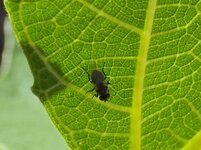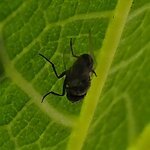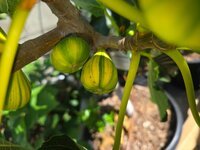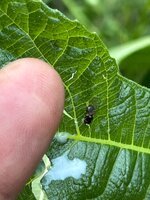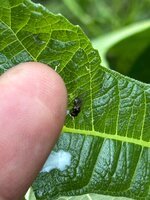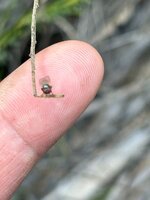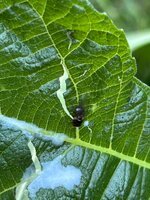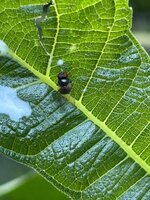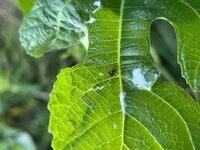You are using an out of date browser. It may not display this or other websites correctly.
You should upgrade or use an alternative browser.
You should upgrade or use an alternative browser.
Is this the black fig fly?
- Thread starter Beabchasingizz
- Start date
GoodFriendMike
Moderator
Not the best photo. But does not look like BFF to me.
Figgerlickinggood
Well-known member
This video
Beabchasingizz
Well-known member
I went outside to take more pictures with flash but he's gone. I did take some pics of panache with that looks like BFF damage (hole). I'll probably cut them up later to see.Not the best photo. But does not look like BFF to me.
Attachments
Beabchasingizz
Well-known member
I see a ton of files on my yard. So sorts of sizes and shape. So hard to identify.I have seen a similar looking black fly but 3 mm is way smaller than that. I think I'll say no just based on the size... Wonder what Fig Gazer would say?
GoodFriendMike
Moderator
I get damage like that here with no BFF.I went outside to take more pictures with flash but he's gone. I did take some pics of panache with that looks like BFF damage (hole). I'll probably cut them up later to see.
For your sake. I hope when you cut it open.
There is no BFF larvae
Franfig
Well-known member
This are some photos I took from a wild fig here in San Diego. The flying patterns and no sounds like fig gazer mentioned. My finger for size reference. It was attracted to the sap and was eating it. Hope it helps.
Attachments
Beabchasingizz
Well-known member
Bad news.I get damage like that here with no BFF.
For your sake. I hope when you cut it open.
There is no BFF larvae
Attachments
Beabchasingizz
Well-known member
I just replied above with a picture of the larve.This are some photos I took from a wild fig here in San Diego. The flying patterns and no sounds like fig gazer mentioned. My finger for size reference. It was attracted to the sap and was eating it. Hope it help
What's my plan of action now?
Beabchasingizz
Well-known member
I have 2 7-10 gal pot, one in ground and probably 15 5gal pots less than 2-3 feet trees. I think I can bag the 7-10 gal trees but those have the most developed figs, probably a lot are infected. I probably need to look through those.Do you have many trees? If not, maybe bagging with organza bags might be worth it.
When is the ideal size to bag the figs?
If there are holes in the figs, doesn't that mean they fell from the figs into the soil? Do I need to treat my soil with BT or spinosad?
Last edited:
GoodFriendMike
Moderator
Yeah really bad news. Sucks.Bad news.
ZomVee
Well-known member
I have 2 7-10 gal pot, one in ground and probably 15 5gal pots less than 2-3 feet trees. I think I can bag the 7-10 gal trees but those have the most developed figs, probably a lot are infected. I probably need to look through those.
When is the ideal size to bag the figs?
If there are holes in the figs, doesn't that mean they fell from the figs into the soil? Do I need to treat my soil with BT or spinosad?
Ummmm, yeah, they probably are in your soil, but I left San Diego before I ever tried anything, so I don't know what to advise you on with treatment. Bag'em as early as possible I would say.
TorontoJoe
Administrator
I think Zom is correct. You can bag and you can spray. I'm told spraying will keep the BFF away but also blastophaga. It would be nice to see a bag that would keep one out and allow the other in.
The only other method that I recall working in your area is this from @Figology
"Spinosad is considered practically non-toxic to wildlife, including birds and mammals."
You can rinse them if you want, but by the time the fig is ready, the damage to the skin is done and most of the poison is inert. Spinosad's half-life on leaves is 2 to 16 days.
The only other method that I recall working in your area is this from @Figology
"Spinosad is considered practically non-toxic to wildlife, including birds and mammals."
You can rinse them if you want, but by the time the fig is ready, the damage to the skin is done and most of the poison is inert. Spinosad's half-life on leaves is 2 to 16 days.
Fig Gazer
Well-known member
I am getting tired of explaning BFF and its defense ,it looks for figs to lay eggs in by size and sent ,MOST ostiale blocks have side effects depending on the micro climate of your trees .net/organza bags if aplied before the fly gets to the fig will keep it from being infested but causes high % of spoiledge and or desication ,mesh size is easy to find that will keep BFF out but allow wasp in .tape over ostiale works but must be re aplied as fig grows and tape falls off ,also effects fig ripening to some degree ,full branch/tree insect bags often cause heat/humidity effects on fig development .a semi weekly pesticide aplication with two different chemicals will stop BFF and the wasp !oils and sent aplications may help .soil drenches and poision baiting/traping have some utility ,but are over welmed if your naborhood has a lot of untreated fig trees . i am having some succes by growing "sacraficial" fig trees in my orchard(WHITE GENOA) that BFF loves and will infest and ruin ever single breba and main crop fig it produces (by the hundreds). AT the same time other var. only 5 feet away are mostly left alone !(around 10-30% infestation .) I am running lots of other exparaments based on the BFF zig/zag flite and avoidance of spider webs (lots of spiders never seen a BFF in a web). I MAKE THE SOIL UNDER MY WHITE GENOA A DEADLY NEST FOR ANY MAGGOT OR IMERGING FLY ,PLUS SYSTEMIC POSION IN THE TREE ITSELF .Does not stop naborhood BFF but consintrates and kills a lot of BFF offspring and i would not eat a fig from this WHITE GENOA should it ripen one . PLEASE READ THIS /HATE TO SEE SO MANY OF YOU RE INVENTING SQUARE WHEELS ! CAPTAN JACKS DEAD BUG ON OSTIALE FULL STRENTH CAUSES A BLACK STAIN AND SO FAR NO RIPE FIGS FOR ME ?GOOD LUCK ! GROWING FIGS USED TO BE SO SIMPLE !!!!!!!!!
ZomVee
Well-known member
Yo, knowledge drop!I am getting tired of explaning BFF and its defense ,it looks for figs to lay eggs in by size and sent ,MOST ostiale blocks have side effects depending on the micro climate of your trees .net/organza bags if aplied before the fly gets to the fig will keep it from being infested but causes high % of spoiledge and or desication ,mesh size is easy to find that will keep BFF out but allow wasp in .tape over ostiale works but must be re aplied as fig grows and tape falls off ,also effects fig ripening to some degree ,full branch/tree insect bags often cause heat/humidity effects on fig development .a semi weekly pesticide aplication with two different chemicals will stop BFF and the wasp !oils and sent aplications may help .soil drenches and poision baiting/traping have some utility ,but are over welmed if your naborhood has a lot of untreated fig trees . i am having some succes by growing "sacraficial" fig trees in my orchard(WHITE GENOA) that BFF loves and will infest and ruin ever single breba and main crop fig it produces (by the hundreds). AT the same time other var. only 5 feet away are mostly left alone !(around 10-30% infestation .) I am running lots of other exparaments based on the BFF zig/zag flite and avoidance of spider webs (lots of spiders never seen a BFF in a web). I MAKE THE SOIL UNDER MY WHITE GENOA A DEADLY NEST FOR ANY MAGGOT OR IMERGING FLY ,PLUS SYSTEMIC POSION IN THE TREE ITSELF .Does not stop naborhood BFF but consintrates and kills a lot of BFF offspring and i would not eat a fig from this WHITE GENOA should it ripen one . PLEASE READ THIS /HATE TO SEE SO MANY OF YOU RE INVENTING SQUARE WHEELS ! CAPTAN JACKS DEAD BUG ON OSTIALE FULL STRENTH CAUSES A BLACK STAIN AND SO FAR NO RIPE FIGS FOR ME ?GOOD LUCK ! GROWING FIGS USED TO BE SO SIMPLE !!!!!!!!!
Yeah, they did seem to pick on certain varieties for sure.
Beabchasingizz
Well-known member
I wonder if this permethrin powder should work. Dab it into the eye, it should last 4 weeks. I think if you do it before the egg hatches, it should kill it when it hatches. The fly also might die when it touches it. You would need to reapply after rain, although we don't get much rain in SD.

 bonide.com
bonide.com

Eight Insect Control Garden Dust - Bonide
Vegetable garden insecticide that kills and repels most insect pests common to home gardens.
 bonide.com
bonide.com
Figless
Well-known member
@Inflorescence had a famous thread where she mostly explores various lures in great depth. Near the end of this 160 something posts the Department of Agriculture is mentioned because they write a letter to a poster who now escapes my memory. Department of AG mentions that they have made some progress with Spinosad 12 drench. I'm sure I'm remembering this voluminous thread incorrectly but it would be wonderful if she would ever consider importing or posting this book of a thread here at figfanatic. It really doesn't serve us to have to go to ((that Library)) to look up the Intel since many of the posters including the writer of the main thread are members here. Every bit of that thread has revelance maybe we could import it? @Inflorescence would you please help. @Fig Gazer also knows chemical drenches that are effective, but that he does not wish to consume figs grown in such pesticidal chaos. He will certainly not recommend it @MattK has a predatory grub offensive half planned out to attack the BFF larvae within the soil before they emerge up to six times in a year. Unfortunately I am not intelligent enough to be of much use ATM. Once the larvae is in your soil you must use a drench. That drench could certainly include a percentage of hydrogen peroxide along with spinosad 12 or whatever the Department of Agriculture deems somewhat effective. Also @Inflorescence incredible work with lures, would be a big part of any solution. I would imagine rotational drenches that includes hydrogen peroxide would likely be effective, and then of course rotational predatory grub attacks, then mesh tent like enclosures. These must include internal solar powered fans Within the 2 mm approximate netting. To keep air flow constant, and the humidity down. LOL we all know the people who will eventually solve this, and it certainly isn't me.
@TorontoJoe , and @GoodFriendMike please feel free to completely redact this post since it is incomplete at best, and it's time has not come, plus it borrows from people
(who have not) given their permission to have their work included.
@TorontoJoe , and @GoodFriendMike please feel free to completely redact this post since it is incomplete at best, and it's time has not come, plus it borrows from people
(who have not) given their permission to have their work included.
Last edited:

